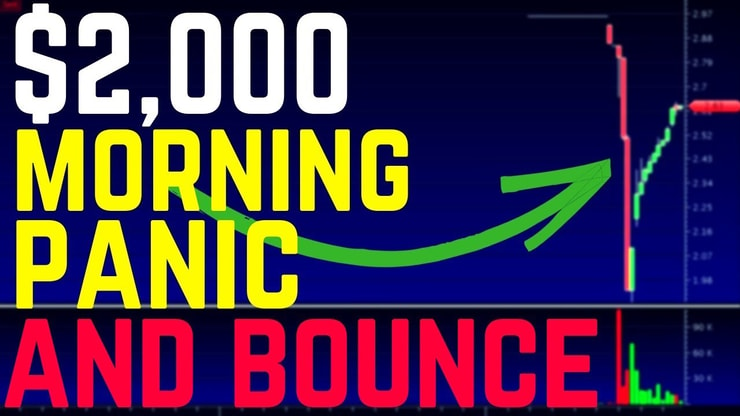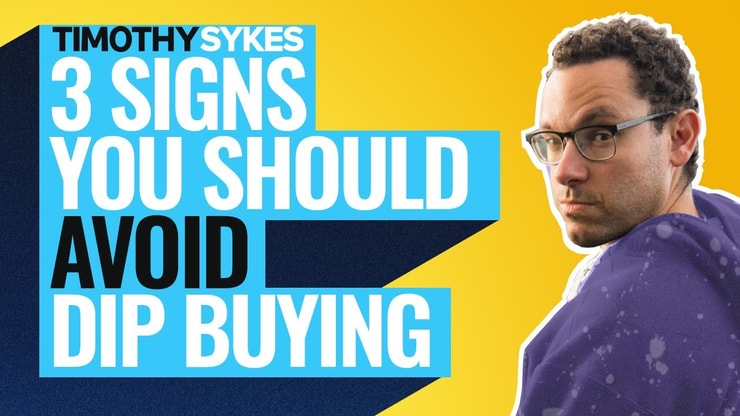‘Buy the dip’ is our generation’s ‘buy low, sell high.’
Both can be good approaches to the market. But neither has stopped traders from blowing up their accounts.
So today we’re gonna unpack the buy the dip meme. I’ll show you what a dip looks like on a stock chart. Then we’ll talk about how you can trade this pattern.

I also want you to know why this is such an awesome part of the market today. It’s not just because buying the dip can be such a repeatable strategy in this market. It’s also because it’s your first lesson in seeing the market in Matrix time.
Picture this: A stock is running in premarket. It’s got several green days behind it, and everyone wants in. It rockets up 50% … 75% … 100%.
Then the market opens, the early traders cash out, and it slams back down.
Is this a bad sign? Sometimes. But it can also be your opportunity to catch the stock before its next spike.
If I’m making it sound simple, I apologize. It’s not. You need to understand what’s a future breakout and what’s built on hot air from sketchy promoters and chat rooms.
If you’re new to this, start studying with my FREE penny stock guide. This will give you the lay of the land. And then watch my YouTube playlist, “30 Trading Videos in 30 Days.” These videos will take you through a ton of trading basics.
You might be looking for a surefire way of making money off the market. There’s nothing like that anywhere, but I’ll give you the closest thing to it…
Work your butt off learning these concepts.
Table of Contents
- 1 What Is Buying the Dip?
- 2 What’s Considered a Dip in the Stock Market?
- 3 Buy the Dip vs. Buy and Hold
- 4 The Benefits of Buying the Dip
- 5 What Are the Risks When Buying the Dip?
- 6 Buy the Dip in Bitcoin
- 7 When Should You Buy the Dip? 4 Tips to Find Dropping Stocks
- 8 Is Buying the Dip a Good Trading Strategy?
- 9 Frequently Asked Questions About Buying the Dip
- 10 The Bottom Line — Should You Consider Buying Dips?
What Is Buying the Dip?

2025 Millionaire Media, LLCBuy the dip can change meaning, depending on your trading strategy.
At its most basic, a dip is a chart pattern where a stock pulls back after uptrending. Theoretically, the uptrend should continue after the dip.
What’s Considered a Dip in the Stock Market?

2025 Millionaire Media, LLCI’m a big fan of intraday dip buying, like in the video above. But buying the dip can happen in any time frame.
Longer-term traders might look for patterns in the past year or five. They’re looking at a stock’s long-term trend. For them, a dip should be a small interruption in this trend.
A great example of a dip in a longer time frame is the March 2020 crash. Stocks uptrending before March have recovered to their pre-crash levels and more. For long-term traders, this represented a prime dip-buying opportunity.
I’m primarily a day trader. This doesn’t mean I won’t be looking at a stock’s chart for evidence of a continuing uptrend. But I’m also looking for a stock to recover on the day when I dip buy long.
This means that I look more to market mechanics than long-term trends. A perfect dip buy for me is a recent runner … I want to see a fall near the market open when some traders take profits and other traders get stopped out.
Then I rely on dip buyers who missed the initial run-up and short sellers who are buying to cover. This waiting audience usually brings the stock’s price back up.
I’m relying on market psychology, not anything fundamental about the stock, in my dip buys. I don’t have any deep belief in the stock itself. If it fails, I get out quick.
Buy the Dip vs. Buy and Hold

2025 Millionaire Media, LLCTraditional advice is that trying to time the market is a bad idea. Market experts advocate the tried-and-true buy-and-hold strategy. They point to research that shows the passive approach always beats the active.
For the most part, this advice is absolutely correct. But you’ve gotta understand where it’s coming from.
These keepers of the great tradition of trading are correct because most dip buyers are in the money mindset. Yep, they’ve got the greed bad. They see a stock dropping 30%, 40%, and assume it will bounce right back up after they buy it.
This is why they invented the phrase, “Don’t try to catch a falling knife.” If the knife in question is a sketchy penny stock, it might even land in your foot.
But for dip buyers who know what they’re doing, this advice is just insulting. It’s another version of “Don’t try this at home, kids.”
Buying the dip could potentially work for you if you have a system and follow its rules.
The Benefits of Buying the Dip

2025 Millionaire Media, LLCWell, there’s one big benefit to start off with — the potential for quick gains if you pull this setup off.
But we’re gonna look past money here. There are a few reasons why this tactic will help build your trading repertoire.
It’s Repeatable
The morning panic dip buy pattern is my favorite because it’s repeatable.
It’s like an omelet recipe. Follow a few basic steps and it will usually be edible. Sometimes it’ll even be great.
It Teaches You How the Market Works
Morning dips feature all my favorite characters in the stock market. There are clueless traders, short sellers looking desperately to cover, and FOMO-filled longs. It’s the human comedy in one chart.
What Are the Risks When Buying the Dip?

2025 Millionaire Media, LLCI know I’ve talked this up. But there are real risks. You have to know when to hold ‘em and when to fold ‘em.
Here’s a PSA on when buying the dip goes wrong… on a very special buy the dip YouTube video:
More Breaking News
- Ondas Strengthens U.S. Drone Manufacturing Through New Partnerships
- Why BTG Stock Could Rebound Soon?
- Why Air Industries Group Stock is Rising
Falling Knives
They really hurt when you try to catch them.
Sketchy Companies
If a stock is free falling, there’s usually a reason. Morning panics don’t usually happen to Apple or Facebook.
Buy the Dip in Bitcoin
For traders who like volatility (like me), bitcoin can be pretty fun.
I personally don’t trade bitcoin, but some of my students say they do.
When bitcoin crashed at the end of 2017, I warned traders not to get too excited about a dip buy. And sure enough, the bounce failed. It would take another year before bitcoin reached the end of this downswing.
Then, just like a penny stock, bitcoin had a ridiculous run-up in 2017. And then came the dip. Then the failed bounce led to lower prices — the real dip.
I never have any attachment to anything I trade. Whether it’s crypto or some stock, traders shouldn’t care where it’s priced. We just want to see volatility, and dips are definitely a part of that.
If you don’t know why volatility is important, don’t pass go, and don’t collect $200. Get my no-cost “Volatility Survival Guide” ASAP.
When Should You Buy the Dip? 4 Tips to Find Dropping Stocks

2025 Millionaire Media, LLC1. The Stock Has Been Up a Lot
I want to dip buy stocks that have been up for several days. The longer it’s up, the bigger the panic can be.
A lot of traders set stop losses near the price they bought the stock at. When the stock falls, it’ll start triggering all these stops. It’ll free fall as the sell orders pile up.
Think of bid-ask like a seesaw. As the stock falls, sell orders start piling up in the ask column. The bids keep getting taken out as the stock tumbles.
You wanna wait until the buyers come in — but that’s not until later.
2. There’s No Bad News
This is my “don’t try this at home, kids.” Even though I’ll occasionally buy the dip on super sketchy stocks, I don’t recommend it. Especially if you’re new to this.
What’s bad news? Maybe the FBI just raided the company’s headquarters. Or maybe the company’s doing a toxic financing.
Avoid companies headed for bankruptcy.
3. It Stabilizes Below a Round Number
Penny stock “investors” — just like us traders, but dumber, right?
One of the dumb things that investors do is catch a sketchy stock in its run-up and hold onto it. It’ll keep grinding up 10%, 20% each day. They feel good and smart and set their stops at a level where they’re comfortable exiting.
But they don’t understand that their trading plan is built on sand. Maybe the stock will gap down through their stop, and their broker will issue a market sell order. They’ll probably get less than they hoped.
Or maybe they’ve set a stop-limit — but odds are it will be too tight to execute in a free fall. So they’re left with a triggered stop and an unexecuted sell order. Hence, the panic.
The stock’s free fall gathers momentum with each round number it crashes through.
Stops tend to cluster in 10- or 25-cent increments. I’m only comfortable buying in once the stock shows support around an odd number. So maybe I’d look for the bottom at $3.91 instead of $4, as an example.
4. Level 2 Shows Support
Level 2 quotes are your friend.
This is where you can see the turn happening. There should be a wall of buyers at the bottom. You see this by the bids stacking up in the Level 2 section of your trading platform.
Now, if you don’t know how to read Level 2 quotes, I’ve got six hours on it right here. Actually, I have a lot more than six hours talking about Level 2. My point is, it’s REALLY important.
If your trading platform doesn’t have Level 2 on it, don’t trade dips until you get one that does.
My preferred platform for Level 2, scans, charts, and more is StocksToTrade. It’s my favorite trading platform out there, and, not coincidentally, the one I helped design. I’m also an investor in it.
StocksToTrade is the complete package for dip buying. It’s got the cleanest and most precise charts out there. The news scanner grabs news catalysts from a ton of sources. The stock screener is built for setups like dip buys.
Is Buying the Dip a Good Trading Strategy?

2025 Millionaire Media, LLCI have a system that I follow with this. You need a system. If you don’t have a system, you might get lucky a few times, but eventually, you’ll crash and burn.
I’m not talking about some kind of complicated ‘buy the dip’ algorithm. But you should be able to list some indicators that you think will move the stock back up.
I’ve got 850+ dip buy video lessons and 550+ morning panic lessons. You get access to them all when you join my Trading Challenge. Just as crucial: You get access to an awesome community of traders.
We believe in transparency at the Challenge. And we have a chat where people don’t just boast about trades. They share their trading plans so you can see how they approached a trade.
And you know what? I believe in transparency so much that I list all of my trades here.
Frequently Asked Questions About Buying the Dip

2025 Millionaire Media, LLCDoes Buying the Dip Really Work?
It works except when it doesn’t work. That’s why you always have an exit plan and cut your losses quickly.
What Happens If I Buy the Dip Every Day?
I don’t encourage you to trade big in the beginning, I encourage you to study big. You may not find the pattern every day. The key is to learn to spot it on your own and be prepared for it with research, a plan, and discipline.
The Bottom Line — Should You Consider Buying Dips?

2025 Millionaire Media, LLCI’ve gotta underline this point. You should do what works for your trading strategy, not what other people say to do. That’s being a self-sufficient trader.
Dip buying has been awesome for me. I think it’s definitely something worth learning. But I’m not gonna encourage you to trade any specific setup.

What I will encourage you to do is to STUDY UP! Keep digging through my no-cost resources, and look at my Trading Challenge when you’re ready.
Whenever that is, rest assured there will be trades.
Do you buy the dip? What did you learn from this article? Let me know about your experiences in the comments!












Leave a reply